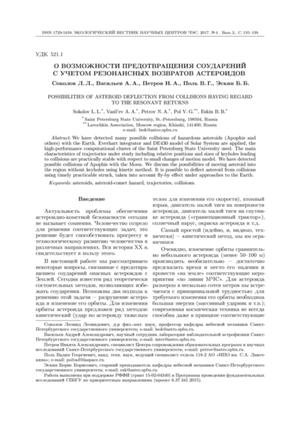О возможности предотвращения соударений с учетом резонансных возвратов астероидов
УДК
521.1EDN
YMTQTPАннотация
Обнаружено много ранее неизвестных возможных соударений и тесных сближений опасных астероидов (Апофиса и других) с Землей. Используется интегратор Эверхарта, и модель DE430, вычисления проводились на компьютерном кластере Санкт-Петербургского государственного университета. Основные характеристики траекторий, такие как относительные положения и размеры щелей, ведущих к соударениям, практически устойчивы относительно малых изменений модели движения. Обнаружены возможные соударения Апофиса с Луной. Обсуждаются возможности перемещения астероидов в области без соударений с использованием кинетического метода. Заблаговременный удар по астероиду в сочетании с эффектом гравитационного маневра при сближениях с Землей может привести к требуемому результату с использованием возможностей современной космической техники.
Ключевые слова:
астероиды, астероидно-кометная опасность, траектории, соударенияИнформация о финансировании
Работа выполнена при поддержке РФФИ (грант 15-02-04340) и Программы проведения фундаментальных исследований СПбГУ по приоритетным направлениям (проект 6.37.341.2015).
Библиографические ссылки
- Ивашкин В.В., Стихно К.А. О предотвращении возможного столкновения астероида Апофис с Землей // Астрономический Вестник, 2009. Т. 43. № 6. C. 502-516. [Ivashkin V.V., Stikhno K.A. O predotvrashchenii vozmozhnogo stolknoveniya asteroida Apofis s Zemley [On the Prevention of a possible collision of asteroid Apophis with the Earth]. Astronomicheskiy vestnik [Astronomical Bull.], 2009, vol. 43, no. 6, pp. 502-516. (In Russian)]
- Эйсмонт Н.А., Боярский М.Н., Ледков А.А., Назиров Р.Р., Данхем Д., Шустов Б.М. О возможности наведения малых астероидов на опасные небесные объекты с использованием гравитационного маневра // Астрономический вестник. 2013. Т. 47. № 4. C. 352-360. [Eysmont N.A., Boyarskiy M.N., Ledkov A.A., Nazirov R.R., Dankhem D., Shustov B.M. O vozmozhnosti navedeniya malykh asteroidov na opasnye nebesnye ob"ekty s ispol'zovaniem gravitatsionnogo manevra [On the possibility of targeting small asteroids to dangerous celestial objects using gravitational maneuver]. Astronomicheskiy vestnik [Astronomical Bull.], 2013, vol. 47, no. 4, pp. 352-360. (In Russian)]
- Соколов Л.Л., Башаков А.А., Питьев Н.П. Особенности движения астероида 99942 Apophis // Астрон. вестн. 2008. Т. 42. № 1. С. 20-29. [Sokolov L.L., Bashakov A.A., Pit'ev N.P. Osobennosti dvizheniya asteroida 99942 Apophis [Features of the motion of the asteroid 99942 Apophis]. Astronomicheskiy vestnik [Astronomical Bull.], 2008, vol. 42, no. 1, pp. 20-29. (In Russian)]
- Соколов Л.Л., Башаков А.А., Борисова Т.П., Петров Н.А., Питьев Н.П., Шайдулин В.Ш. Траектории соударения астероида Апофис с Землей в XXI веке // Астрон. вестн. 2012. Т. 46. № 4. С. 311-320. [Sokolov L.L., Bashakov A.A., Borisova T.P., Petrov N.A., Pit'ev N.P., Shaydulin V.Sh. Traektorii soudareniya asteroida Apofis s Zemley v XXI veke [The trajectories of the impact of the asteroid Apophis with the Earth in the 21st century]. Astronomicheskiy vestnik [Astronomical Bull.], 2012, vol. 46, no. 4, pp. 311-320. (In Russian)]
- Соколов Л.Л., Борисова Т.П., Васильев А.А., Петров Н.А. Свойства траекторий соударения астероидов с Землей // Астрон. вестн. 2013. Т. 47. № 5. С. 441-447. [Sokolov L.L., Borisova T.P., Vasil'ev A.A., Petrov N.A. Svoystva traektoriy soudareniya asteroidov s Zemley [Properties of trajectories of asteroids' impact with the Earth]. Astronomicheskiy vestnik [Astronomical Bull.], 2013, vol. 47, no. 5, pp. 441-447. (In Russian)]
- Соколов Л.Л., Кутеева Г.А. Прогноз возможных соударений астероида Апофис после уточнения его орбиты // Вестник Санкт-Петербургского госуниверситета, 2015. Сер. 1. Т. 2 (60). Вып. 1. C. 148-156. [Sokolov L.L., Kuteeva G.A. Prognoz vozmozhnykh soudareniy asteroida Apofis posle utochneniya ego orbity [The forecast of possible collisions of the asteroid Apophis after the refinement of its orbit]. Vestnik Sankt-Peterburgskogo gosuniversiteta [Bull. of the St. Petersburg State University], 2015, ser. 1, vol. 2 (60), iss. 1, pp. 148-156. (In Russian)]
- Sokolov L.L., Pitjev N.P., Shaidulin V.Sh. About zones of rezonant returns of asteroid apophis // Proc. of the Int. Conf. "Asteroid-Comet Hazard-2009" / Eds. A. Finkelstein, W. Huebner, V. Shor. St-Petersburg: Nauka, 2010. P. 279-283.
- Everhart E. Implicit single-sequence methods for integrating orbits // Celest. Mech. 1974. Vol. 10. P. 35-55.
- Standish E.M. JPL Planetary and Lunar ephemerides, DE405/LE405 / Interoffice Memorandum, 1998. 312. F-98-048. 18 p.
- Near-Earth Asteroid Discovery Statistics Sentry: Earth Impact Monitoring. (Электронный ресурс). URL: http://cneos.jpl.nasa.gov/sentry/ (дата обращения 07.12.2017).
- Yeomans D.K., Bhaskaran S., Broschart S.B. et al. Deflecting a Hazardous Near-Earth Object. 1 IAA Planetary Defense Conference: Protecting Earth from Asteroids, 27-30 April 2009, Granada, Spain. 14 p.
- Chesley S.R. Asteroid impact hazard assessment with Yarkovsky effect. 2011 IAA Planetary Defense Conference: From Threat to Action 9-12 May 2011, Bucharest, Romania. 19 p.
- Farnocchia D., Chesley S.R., Chodas P.W., Micheli M., Tholen D.J., Milani A., Elliott G.T., Bernardi F. Yarkovsky-driven impact risk analysis for asteroid (99942) Apophis. Режим доступа: https://arxiv.org/abs/1301.1607 (дата обращения 19.02.2013).
- Chesley S.R. Potential Impact Detection of Near-Earth Astrroids: The Case of 99942 Apophis (2004 MN4) / Proc. IAU Symposium 229th "Asteroids, Comets, Meteors", 2005 / Eds. Lazzaro D., Ferraz-Mello S., Fernandes J.A. Cambridge: Cambridge University Press, 2006. P. 215-228.
Скачивания

Даты
Поступила в редакцию
Принята к публикации
Публикация
Как цитировать
Лицензия
Copyright (c) 2017 Соколов Л.Л., Васильев А.А., Петров Н.А., Поль В.Г., Эскин Б.Б.

Это произведение доступно по лицензии Creative Commons «Attribution» («Атрибуция») 4.0 Всемирная.


